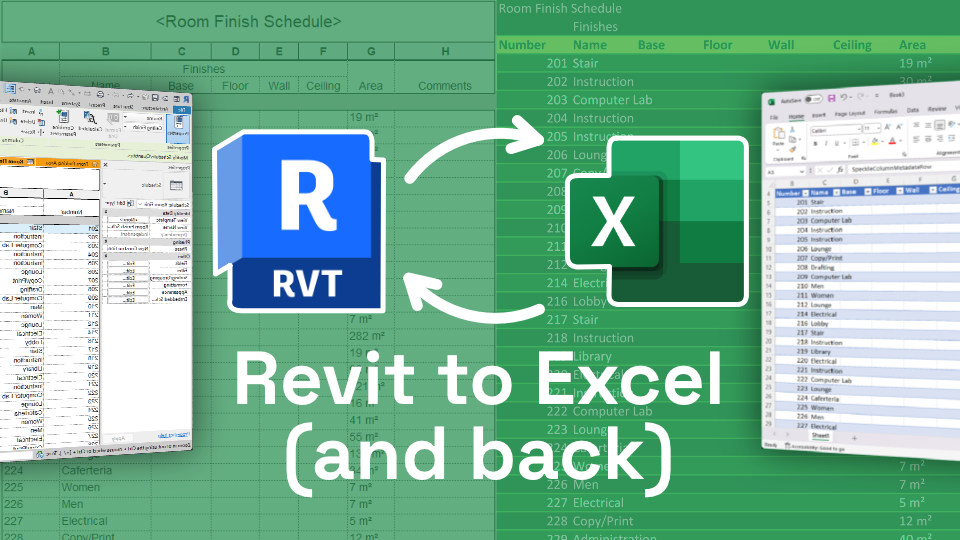Damaging Barriers: Excel Importation Techniques for Advanced Revit Users
Check out different information importation techniques and master Excel combination to improve your Revit modeling abilities. With our suggestions and tricks, you can conquer importation difficulties and come to be a real professional in making use of Excel for your Revit jobs.
Advanced Revit Users: Leveraging Excel for Importation
You can conveniently take advantage of Excel for importation as an innovative Revit customer. Excel is an effective device that can greatly boost your workflow and performance in Revit. With its capability to deal with large quantities of data and execute complicated computations, Excel can be a valuable possession in managing and arranging your task details.
One means to leverage Excel for importation is by utilizing the "Link Excel" function in Revit. This attribute enables you to link an Excel spreadsheet straight right into your Revit project, allowing you to update and synchronize data in between the 2 programs. When dealing with timetables or tracking changes in your project., this can be specifically helpful.
One more method to utilize Excel is by utilizing the "Import/Export" function in Revit. This attribute allows you to import and export information in between Revit and Excel, providing you the versatility to collaborate with data in both programs. You can import information from Excel into Revit to produce aspects such as doors, spaces, or wall surfaces, and you can likewise export data from Revit to Excel for further analysis or reporting.

Exploring Data Importation Methods in Revit Using Excel
Checking out how to import information from Excel into Revit uses efficient methods for integrating information. When you import data from Excel, you can perfectly move data such as area schedules, product checklists, and equipment information into your Revit job. This procedure permits you to conserve effort and time by preventing manual information entrance.
To import data from Excel into Revit, you can utilize the "Import/Export" function. This attribute allows you to map the Excel information areas to the corresponding Revit criteria, guaranteeing that the information is properly designated within the design. By choosing the proper import choices, you can manage exactly how the data is imported and just how it engages with your job.
Another approach for importing data from Excel into Revit is by utilizing Eager beaver. Eager beaver is a visual programming device that integrates with Revit and allows you to automate tasks and operations. With Dynamo, you can create custom scripts that import information from Excel and control it within your Revit project. This technique offers a lot more adaptability and customization alternatives.
Grasping Excel Assimilation for Advanced Revit Modeling
One essential strategy is importing information from Excel spread sheets directly into your Revit design. With a couple of easy actions, you can map the Excel columns to the matching Revit parameters and import the information properly.
An additional helpful approach is exporting data from Revit to Excel. This enables you to remove details from your design, such as routines or material quantities, and evaluate it in Excel making use of formulas, charts, or various other effective devices. By leveraging the abilities of Excel, you can do intricate calculations, produce customized reports, and gain important understandings into your task.
Along with information transfer, Excel integration can automate repetitive jobs in Revit. By creating macros or scripts in Excel, you can automate processes like creating views, creating sheets, or using standard family members - revit plugins. This not only conserves time but also guarantees uniformity throughout your job
To understand Excel integration in Revit, it is important to comprehend the data framework and just how Revit engages with Excel. By familiarizing on your own with the available tools and methods, you can unlock the complete possibility of Excel combination and take your Revit modeling to the following level.
Conquering Importation Challenges: Excel Techniques for Revit Experts
When getting rid of importation obstacles, it's vital to be acquainted with effective Excel techniques that can profit professionals in Revit. As a sophisticated Revit individual, you understand the relevance of flawlessly importing information from Excel right into your jobs.

Another useful method is utilizing the "Transpose" feature in Excel. This enables you to transform data from rows to columns or the other way around. When importing data into Revit, this can be particularly helpful when you have information in a vertical format in Excel, but you need it to be in a horizontal format in Revit.
Additionally, making use of Excel formulas such as VLOOKUP and INDEX-MATCH can considerably aid in mapping information from Excel to Revit. These solutions allow you to look for certain values in Excel and get matching information from an additional column. When importing huge datasets right into Revit., this can conserve you time and effort.
Excel Data Importation Advice for Advanced Revit Users
By familiarizing on your own with reliable Excel tips and methods, you can enhance your data importation process as an advanced individual of Revit. Furthermore, using Excel's "Paste Special" feature permits you to paste data from Excel into Revit while keeping format, such as cell color or font design. Another handy method is to use Excel's "Replace and discover" feature to swiftly make modifications to your data before importing it right into Revit.
Verdict
You have currently found out beneficial methods for importing data from Excel into Revit as an advanced customer. Go ahead, damage those obstacles import excel into revit and stand out in your Revit projects!

When importing data into Revit, this can be specifically useful when you have information in a vertical layout in Excel, but you need it to be in a straight format in Revit.
In addition, using Excel formulas such as VLOOKUP and INDEX-MATCH can substantially help in mapping data from Excel to Revit. Additionally, making use of Excel's "Paste Unique" attribute enables you to paste data from Excel into Revit while preserving formatting, such as cell shade or font design.